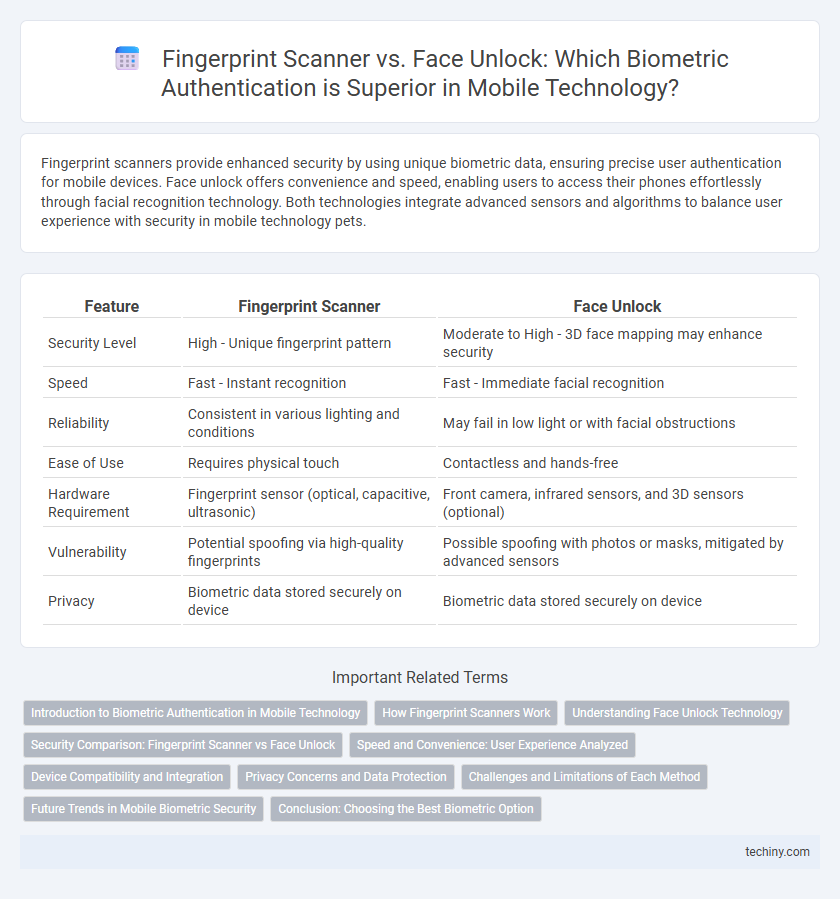Fingerprint scanners provide enhanced security by using unique biometric data, ensuring precise user authentication for mobile devices. Face unlock offers convenience and speed, enabling users to access their phones effortlessly through facial recognition technology. Both technologies integrate advanced sensors and algorithms to balance user experience with security in mobile technology pets.
Table of Comparison
| Feature | Fingerprint Scanner | Face Unlock |
|---|---|---|
| Security Level | High - Unique fingerprint pattern | Moderate to High - 3D face mapping may enhance security |
| Speed | Fast - Instant recognition | Fast - Immediate facial recognition |
| Reliability | Consistent in various lighting and conditions | May fail in low light or with facial obstructions |
| Ease of Use | Requires physical touch | Contactless and hands-free |
| Hardware Requirement | Fingerprint sensor (optical, capacitive, ultrasonic) | Front camera, infrared sensors, and 3D sensors (optional) |
| Vulnerability | Potential spoofing via high-quality fingerprints | Possible spoofing with photos or masks, mitigated by advanced sensors |
| Privacy | Biometric data stored securely on device | Biometric data stored securely on device |
Introduction to Biometric Authentication in Mobile Technology
Biometric authentication in mobile technology leverages unique physiological traits such as fingerprints and facial features to enhance device security. Fingerprint scanners offer quick and reliable access through touch recognition, while face unlock systems use advanced facial mapping and infrared sensors for hands-free authentication. Both methods improve user convenience and protect sensitive data by minimizing reliance on traditional passwords.
How Fingerprint Scanners Work
Fingerprint scanners utilize capacitive or optical sensors to capture the unique patterns of ridges and valleys on a user's fingertip, converting these into digital data for biometric authentication. Capacitive scanners measure the electrical current differences caused by the fingerprint's ridges and pores, while optical scanners create a visual image using light to detect fingerprint details. This technology ensures secure and fast device access by matching stored fingerprint data with the live scan during each unlock attempt.
Understanding Face Unlock Technology
Face unlock technology employs advanced facial recognition algorithms and infrared sensors to create a detailed 3D map of the user's face, enhancing security and accuracy compared to traditional 2D methods. This biometric system adapts to variations in lighting, angles, and facial changes, ensuring seamless and reliable authentication. Unlike fingerprint scanners, face unlock offers a touchless experience, leveraging AI-driven depth analysis and liveness detection to prevent spoofing.
Security Comparison: Fingerprint Scanner vs Face Unlock
Fingerprint scanners provide a highly secure biometric authentication method by using unique sweat pore patterns and ridges, making them difficult to replicate or spoof. Face unlock systems rely on facial recognition technology, which can vary in security depending on whether 2D image scanning or advanced 3D depth sensing is used, with 3D methods offering stronger protection against spoofing. Security evaluations show fingerprint scanners generally offer consistent reliability, while face unlock security depends heavily on sensor quality and software algorithms.
Speed and Convenience: User Experience Analyzed
Fingerprint scanners offer rapid, reliable access with a typical recognition time under 0.5 seconds, providing seamless convenience for one-handed use. Face unlock systems employ advanced facial recognition algorithms, unlocking devices in approximately 1 second, enhancing hands-free convenience but sometimes struggling with low-light conditions. User experience varies by context; fingerprint scanners excel in speed and accuracy, while face unlock prioritizes convenience during multitasking or when hands are occupied.
Device Compatibility and Integration
Fingerprint scanners offer broad device compatibility due to their compact sensor design, easily integrated into smartphones, tablets, and laptops with minimal hardware adjustments. Face unlock requires advanced front-facing cameras and infrared sensors, limiting integration primarily to higher-end devices with specialized hardware. Both biometric methods depend on seamless software integration within the operating system for secure and efficient authentication across diverse device ecosystems.
Privacy Concerns and Data Protection
Fingerprint scanners store unique biometric data locally on the device, minimizing exposure risks and enhancing user privacy by avoiding cloud storage vulnerabilities. Face unlock systems often process facial recognition data through device-specific neural engines, but concerns arise over potential unauthorized access and data breaches if biometric templates are not securely encrypted. Both technologies require robust encryption standards such as AES-256 and secure enclave implementations to ensure data protection against hacking and unauthorized surveillance.
Challenges and Limitations of Each Method
Fingerprint scanners face challenges such as reduced accuracy with wet or dirty fingers and difficulties recognizing fingerprints of elderly users with worn skin patterns. Face unlock systems struggle in low-light conditions, and can be less secure against high-quality photo or video spoofing attacks. Both methods face limitations in universality and environmental robustness, impacting consistent user authentication performance.
Future Trends in Mobile Biometric Security
Fingerprint scanners and face unlock features are evolving with advancements in AI and machine learning, enhancing accuracy and speed for mobile biometric security. Emerging trends include multimodal authentication combining fingerprint and facial recognition to boost security against spoofing attacks. Integration of 3D facial mapping and ultrasonic fingerprint sensors is set to redefine user authentication, balancing convenience with robust protection on next-generation smartphones.
Conclusion: Choosing the Best Biometric Option
Fingerprint scanners provide high accuracy and security with fast authentication, ideal for consistent use in various lighting conditions. Face unlock offers convenience and speed, excelling in hands-free situations but may struggle with facial recognition under low light or mask usage. Selecting the best biometric option depends on user preferences for security, environmental conditions, and device compatibility.
Fingerprint Scanner vs Face Unlock Infographic

 techiny.com
techiny.com